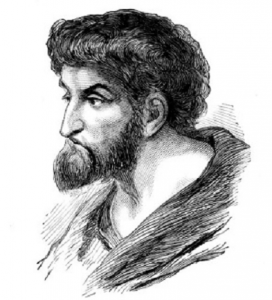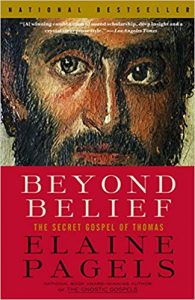Beyond Belief: The Secret Gospel of Thomas
Beyond Belief: The Secret Gospel of Thomas, by Elaine Pagels; published 2003 by Random House, New York; reviewed by Frank Thomas Smith.
Elaine Pagels, professor of religion at Princeton University, became famous – well, at least well known – with the publication of her book, The Gnostic Gospels, in 1979. She has written several other books as well on the history of Christianity, establishing her as the foremost popular scholar in the field.
Beyond Belief, published in 2003 by Random House, is a sort of sequel to The Secret Gospels, in that it incorporates the new scholarship that has come to light since that book was published. Since Ms. Pagels’ infant son was diagnosed with fatal pulmonary hypertension, her pursuit of knowledge about who Jesus really was has become a question of personal urgency for her. This need is reflected in the text and transforms the book into much more than a scholarly treatise for the curious. She wants to know what Christ meant to his followers before doctrine and dogmas, in other words, before Christianity was invented by the Church.
The discovery of the Gospel of Thomas, along with other early Christian texts, offers revealing clues. Pagels compares Thomas’s gospel (which claims to give Jesus’ secret teaching and indicates an affinity with the Kabbalah) with the canonic texts to show how the early Church chose to include some gospels and exclude others from the collection we know as the New Testament – and why. During the time of persecution of Christians, the church fathers constructed the canon, creed and hierarchy, suppressing many of its spiritual resources in the process, in order to avoid conflict with Roman law and religion.
A prime example is the label of heresy attached to the Gospel of Thomas, and its subsequent suppression. If a copy hadn’t been found by accident (or destiny?) in the caves of Nag Hammadi, along with many other documents during the middle of the twentieth century, we’d have never even known of its existence. Such secret writings had been denounced by Irenaeus, bishop of Lyon (c.180) as “an abyss of madness, and blasphemy against Christ.” Pagels had therefore expected to find madness and blasphemy in these texts, but when she first studied them in Harvard graduate school, she found the contrary in sayings such as this from Thomas. “Jesus said: If you bring forth what is within you, what you will bring forth will save you. If you do not bring forth what is within you, what you do not bring forth will destroy you. Pagels found that “… the strength of this saying is that it does not tell us what to believe but challenges us to discover what lies hidden within ourselves; and, with a shock of recognition, I realized that this perspective seemed to me to be self-evidently true.”
However, certain church leaders from the second through the fourth centuries rejected many of these sources of revelation and constructed instead the New Testament gospel canon of Matthew, Mark, Luke and John, which has defined Christianity to this day. The Gospel of John is of special importance in church dogma, and its basic tenets seem to be in direct opposition to Thomas. John says that he writes “so that you may believe and believing may have life in [Jesus’] name.” Thomas’s gospel, however, encourages us not so much to believe in Jesus, as John demands, as to seek to know God through one’s own, divinely given capacity, since all are created in the image of God. “For Christians of later generations, the Gospel of John helped provide a foundation for a unified church, which Thomas, with its emphasis on each person’s search for God, did not.”
According to Pagels, John is the only evangelist who actually states that Jesus is God incarnated. But not only Pagels says so. In one of his commentaries on John, Origen – a church father, (c.240) – writes that while the other gospels describe Jesus as human, “none of them clearly spoke of his divinity, as John does.” One may object that the other three, synoptic (“seeing together”) gospels call Jesus “son of God”, and this is virtually the same thing. But such titles (son of God, messiah) in Jesus’ time designated human, not divine roles. When translated into English fifteen centuries later, these were capitalized – a linguistic convention that does not occur in the original Greek. When all four gospels, together with Paul’s letters, were united in the New Testament (c. 160 to 360) most Christians had come to read all four through John’s lens, that Jesus is “Lord and God”.
Pagels feels that if the Gospel of Thomas were included in the New Testament instead of that of John, or even if it were included along with John, the development of Christianity would have been quite different. Whereas Mark, Matthew and Luke identify Jesus as God’s human agent, John and Thomas characterize him as God’s own light in human form. Both claim to reveal, at least to a certain extent, Jesus’ “secret teachings”, and assume that their readers are already familiar with the synoptic gospels.

Despite their similarities, John and Thomas point the secret teachings in sharply different directions. John claims that we can experience God only through the divine light embodied in Jesus, while Thomas says that the divine light embodied in Jesus is already shared by humanity since we are all made “in the image of God”. Thomas thus expresses what would become a central theme of Jewish, and later Christian, mysticism a thousand years later: that the “image of God” is hidden within everyone, and it is a question of recognizing this and finding it through one’s own efforts.
(On the question of Jesus’ divinity, Rudolf Steiner – not consulted by Pagels – offered an interesting solution: that Jesus was indeed a human being, but that “a god”, Christ, incarnated in him at the moment of baptism in the Jordan.)
At one point in her description of the dispute among the early Christians about who Jesus really was, Pagels quotes Mark: … he asked his disciples, “Who do people say that I am?” And they told him, “John the Baptist; and others say Elijah; and others, one of the prophets.“ And he asked them, “But who do you say that I am?” Peter answered him, “You are the messiah.” In view of this passage, it has always seemed contradictory to me the contention that Christianity – and Judaism – do not embrace the idea of reincarnation, even reject it, when these first Jewish Christians seem to act as though it were common knowledge.
The synoptic gospels claim that Jesus’ teaching predicted the coming of the kingdom of God some time in the future, an interpretation still adhered to by many Christians. However, both John and Thomas say something different, the latter very specifically: Jesus said, If those who lead you say to you, ‘Look, the kingdom is in the sky’, then the birds of the sky will get there before you. … If they say to you, ‘It is in the sea,’ then the fish will get there before you. And: His disciples said to him, ‘When will the resurrection of the dead come, and when will the new world come?’ He said to them, ‘What you look forward to has already come, but you do not recognize it.’
Though the Gospel of Luke includes an alternative version of the same idea (“… the kingdom of God is within you”), Luke later retreats from this position and concludes with the apocalyptic warning that the Son of Man is not a divine presence in us all but a terrifying judge.
A century ago Leo Tolstoy, in his monumental The Kingdom of God is Within you, urged Christians to give up coercion and violence in order to realize God’s kingdom here and now. Thomas Merton, the twentieth century writer and Trappist monk, agreed with Tolstoy but interpreted his kingdom mystically rather than practically. We are confronted here with the Catholic church’s insistence that humanity is sinful, base and unworthy by nature and that salvation from the pangs of hell is only possible through faith in Jesus and, by obvious extension, his church, and his representative on earth, the pope. But the Gospel of Thomas leaves spiritual destiny up to each individual. There Jesus treats us as equals, or at least as struggling siblings:
“According to Thomas, Jesus rebukes those who seek access to God elsewhere, even — perhaps especially — those who seek it by trying to “follow Jesus” himself. When certain disciples plead with Jesus to “show us the place where you are, since it is necessary for us to seek it,” he does not bother to answer so misguided a question and redirects the disciples away from themselves toward the light hidden within each person: ‘There is light within a person of light, and it lights up the whole universe; If it does not shine, there is darkness.’ In other words, one either discovers the light within that illuminates ‘the whole universe’ or lives in darkness, within and without.”
Finally, after so many centuries, the heretics are having their say. Another most interesting document found at Nag Hammadi is the Gospel of Philip, who explains baptism. Sometimes the person who receives baptism “receives the holy spirit … this is what happens when one experiences a mystery.” Divine grace, this implies, isn’t sufficient; the initiate’s capacity for spiritual understanding is also a factor. “Faith is our earth, in which we take root; hope is the water through which we are nourished; love is the air through which we grow; gnosis is the light through which we become fully grown.
For translations of the Gospel of Thomas see: http://home.epix.net/~miser17/Thomas.html
Review by Frank Thomas Smith
